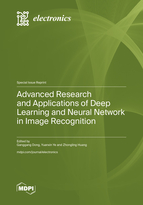Advanced Research and Applications of Deep Learning and Neural Network in Image Recognition
A special issue of Electronics (ISSN 2079-9292). This special issue belongs to the section "Computer Science & Engineering".
Deadline for manuscript submissions: closed (15 July 2023) | Viewed by 17981
Special Issue Editors
Interests: target detection and recognition; deep learning; synthetic aperture radar
Interests: image registration; image matching; image fusion; image segmentation
Special Issues, Collections and Topics in MDPI journals
Interests: SAR target recognition; transfer learning; unsupervised learning
Special Issues, Collections and Topics in MDPI journals
Special Issue Information
Dear Colleagues,
Over the past two decades, few developments have been more astounding than the rapid progress achieved in image recognition. Object detection performance rates skyrocketed from approximately 30 percent in mean average precision to more than 90 percent for the PASCAL VOC benchmark. Likewise, state-of-the-art learning algorithms even exceed human performance for image classification in the ImageNet dataset. These improvements in image classification have significant impacts on a wide range of practical applications, including video surveillance, autonomous driving, intelligent healthcare, remote sensing image interpretation, and artificial intelligence.
The major driving force behind the recent advances in image classification lies in deep learning algorithms. The success of deep learning is powered by two crucial issues: large-scale training datasets and powerful computational platforms. In most cases, the performances obtained by deep neural networks are much better than those of hand-crafted delicate image features in various image classification tasks. Yet, despite the great success of deep learning in image recognition so far, there are still numerous challenges to overcome. The aim of this Special Issue is to present new solutions to these challenging problems. Topics of interests include but are not limited to the following issues:
- The improvement of model generalization ability, i.e., how to train the deep models that generalize well in real-world scenarios that have not been seen in training.
- The improvement of learning efficiency in small data environments. Current techniques generally break down if few labeled examples are available. This should be carefully considered in practical applications.
- Lightweight neural networks oriented to this specific task.
- The integration of prior knowledge in deep learning.
- The multitask deep learning technique.
The meta deep learning under a certain background.
Dr. Ganggang Dong
Dr. Yuanxin Ye
Dr. Zhongling Huang
Guest Editors
Manuscript Submission Information
Manuscripts should be submitted online at www.mdpi.com by registering and logging in to this website. Once you are registered, click here to go to the submission form. Manuscripts can be submitted until the deadline. All submissions that pass pre-check are peer-reviewed. Accepted papers will be published continuously in the journal (as soon as accepted) and will be listed together on the special issue website. Research articles, review articles as well as short communications are invited. For planned papers, a title and short abstract (about 100 words) can be sent to the Editorial Office for announcement on this website.
Submitted manuscripts should not have been published previously, nor be under consideration for publication elsewhere (except conference proceedings papers). All manuscripts are thoroughly refereed through a single-blind peer-review process. A guide for authors and other relevant information for submission of manuscripts is available on the Instructions for Authors page. Electronics is an international peer-reviewed open access semimonthly journal published by MDPI.
Please visit the Instructions for Authors page before submitting a manuscript. The Article Processing Charge (APC) for publication in this open access journal is 2400 CHF (Swiss Francs). Submitted papers should be well formatted and use good English. Authors may use MDPI's English editing service prior to publication or during author revisions.
Keywords
- deep learning
- model generalization
- multitask learning
- small sample size
- meta-learning
- specific data augmentation








